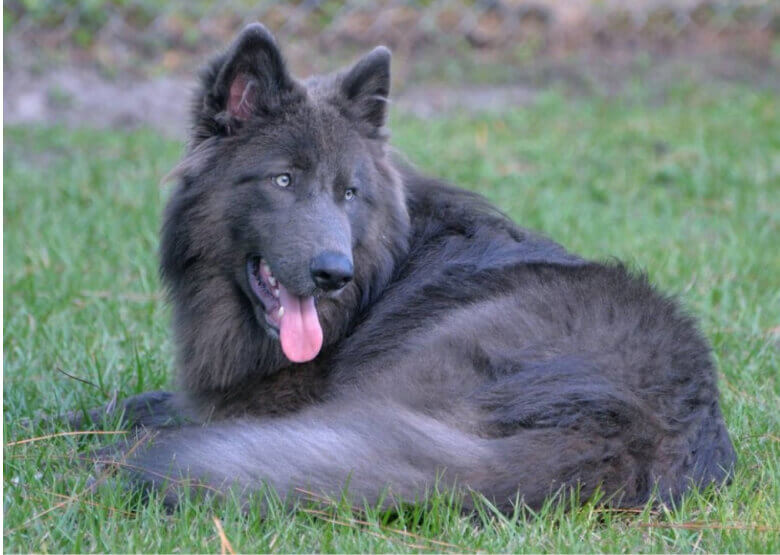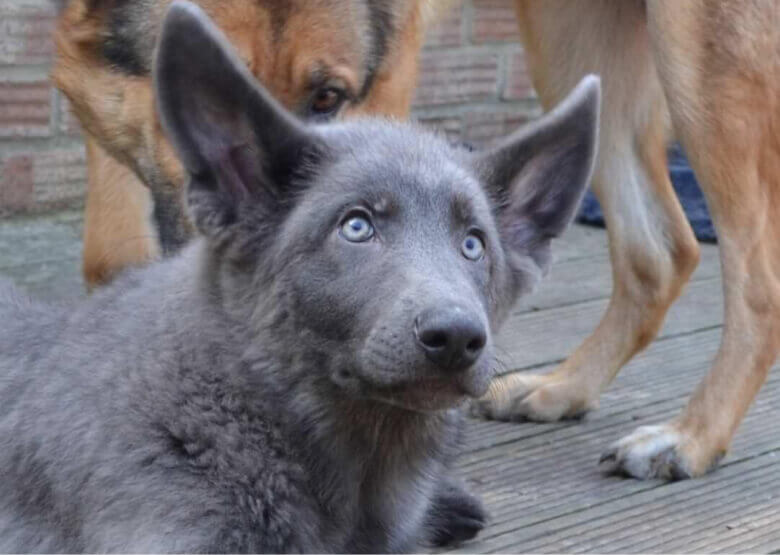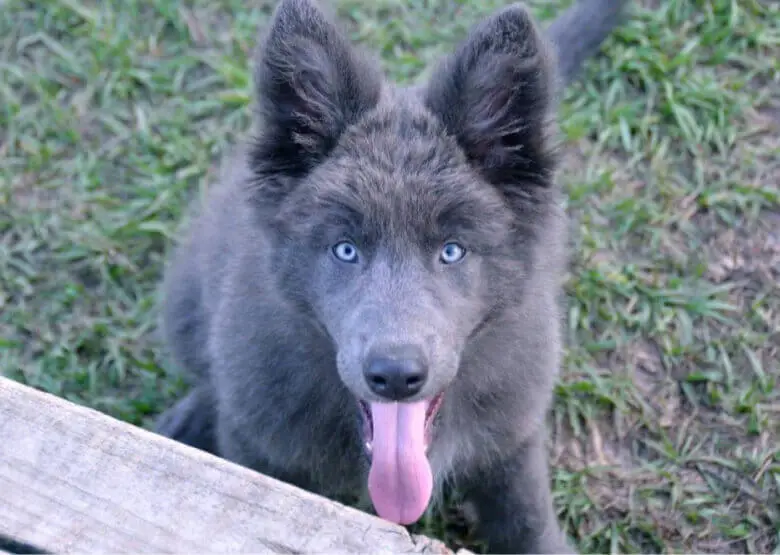Table of Contents
German Shepherds can be of different colors – tan, red, sable, liver, black, white, gray, or a mix of them. This article is devoted to one more very interesting and rare variety of this breed – a blue German Shepherd dog. You will learn about the origins of this color in dogs caused by genetics, their appearance and behavior, popular myth and misconceptions related to them, and the possible differences of these animals from other Shepherd dogs.
If you are interested in getting a loyal friend of magnificently unusual color and look, this information will be very helpful for you. So, let’s start.
Origins and History of a Blue German Shepherd Dog
This variety of German Shepherds is very attractive. The dogs are not really blue. It is a diluted black color that looks quite specific. Despite many myths and wrong beliefs, there are not any sufficient differences in the overall look and behavior of such doggies. Moreover, it is not a separate breed as some people may believe.
That is why the history of a blue GSD started simultaneously with the history of a German Shepherd as a breed. Sometime in the middle of the 19th century, a retired German Cavalry officer, Max von Stephanitz by name, decided to breed the most perfect canines for his sheep farms. It took him about forty years to complete the process and obtain a working dog that could deal with herding and guarding.
Of course, a blue coat German Shepherd is not navy-blue or sky-blue. It looks like its immediate predecessor – a wolf – but only a bit darker. Such a color is also called diluted black. The color is a result of completely disabled ‘D’ genes. A ‘D’ gene produces a deep black color. Parents with the ‘DD or ‘Dd’ combinations of genes are unlikely to produce blue-coated offspring. Though, the latter combination can sometimes result in this if both parents do have it.
As you have already understood, ‘D’ stands for a black color. And what about ‘d’? Geneticists argue that it stands for blue or diluted black. This gene can completely block black, resulting in an ultimate blue.
The Dd combination can produce blue in rare cases because the dominant ‘D’ usually takes over the recessive blue ‘d’. In the case of the ‘dd’ combination in both parents or just one of them, the possibility of a blue puppy increases because ‘d’ becomes dominant. If both a sire and a dam have a ‘dd’ combination, it can result in a light blue German Shepherd which is also a variety of the breed distinguished by the color only, but not by the temperament or behavior.
Characteristic Features and Appearance of a Blue GSD

A blue colored German Shepherd does not differ much from the dogs of other colors belonging to this breed. They are medium-to-large canines with a lifespan of 10-13 years.
These animals look beautiful and quite aesthetic. They are not allowed for shows, though, in the USA because the American Kennel Club considers the diluted color a big fault.
Apart from such an unusual color, they have a different pigmentation of noses, eye rims, and paw-pads. Most blue Shepherds can boast blue eyes and gray-blue pads like representatives of another diluting gene modification – an Isabella German Shepherd whose color is a diluted liver caused by a ‘d’ gene.
The coat of these blue Shepherds has the brush tint on the main gray, so it’s just a shade of gray or washed-out black that reminds of blue. There are some minor variations of this shading, such as bicolor, sable, saddle, or solid blue. You can also come across dark-steel blue or light-powder blue, and other variants. These colors look magnificent, indeed. So, if you are a German Shepherd enthusiast, this dog is right for you.
Not all blue Shepherds have blue eyes. Even if a puppy was born with this eye color, it may change to light brown or amber over time.
The coat can be either long or medium. It is doubled with a dense protective upper layer and a soft undercoat that helps withstand weather conditions. The blue GSD can shed a lot, so it needs frequent brushing and grooming all the time.
The size does not differ much from the standard German Shepherd’s size. Males grow to 24-26 inches or 60-66 cm tall, and their weight varies between 65-90 pounds or 29-40 kg. Females are smaller and more gracious. They are 22-24 inches or 55-60 cm tall and 50-70 pounds or 22-31 kg heavy. The color cannot determine the size of the dog, either.
A blue coat German Shepherd does not make a good apartment dog because it is too big and needs a lot of activity and exercise. However, if you can provide your pet with enough room and regular movement, you can enjoy it as your house dog.
Behavior and Training

Like all other German Shepherd dogs, a blue GSD is very athletic and strong. A lot of energy requires good amounts of exercise. These dogs are intelligent, brave, faithful, and protective. They are quite independent and aloof to strangers if trained properly.
That said, private homes and landed properties are the best space if you consider acquiring this animal. These dogs need a lot of socializing and dedicated training. If they do not receive that, they may express aggressiveness and separation anxiety. You cannot even think about chaining them up.
The blue Shepherd’s behavior is the same as that of representatives of this breed with any other colors. Their temperament does not differ much, either. They are incredibly loving and owner-pleasing. That is why you should not leave them alone for a long time.
Health Issues
Blue color does not influence the dog’s health. They say that the diluted genes can cause color dilution alopecia. However, this characteristic is true for Dobermans but not Shepherds. These animals’ health depends more on the specific issues all Shepherds are prone to. They include elbow and hip dysplasia. Dysplasia is a condition when the joints are formed in the wrong way, so they become painful over time. It may even result in lameness. This condition is a characteristic of all big dogs, not only German Shepherds, and it does not relate to their color.
Like all other dogs bred from a single bloodline, Shepherds can suffer from specific genetic mutations. They include degradation of the spinal cord which is called degenerative myelopathy. It is a slowly developing and non-painful condition that becomes more obvious when the animal gets older. They are also prone to congenital heart defects, for example, patent ductus arteriosus, pulmonic stenosis, and aortic stenosis.
Receiving health certificates from the breeder, including X-ray test certificates, will spare you from the need to spend a lot of money on veterinary care.
A Blue German Shepherd Price

A blue colored German Shepherd is quite rare. It is highly appreciated by dog lovers for its stunning color, though breeders are not interested in raising these dogs because such animals cannot participate in shows and competitions. Moreover, there is a rare possibility to get the ‘dd’ gene combination in both parents that can produce blue-coated offspring.
All these factors cause higher prices of such animals. Blue Shepherds can cost you $1,500-$2,500, depending on the breeder’s reputation and a pedigree. The champion pedigree dogs will cost much more.
This variation can also be acquired from adoption centers for at least $50-$350, but there is a slight chance you can find such a dog in a shelter.
Therefore, if you want your dog with an impressive pedigree from a reputable and experienced breeder, it may cost you up to $5,000. Those Shepherds who have the show line or protection traits may even cost more.
Common Myths About a Blue Coat German Shepherd
Now, let’s discuss the common misconceptions and myths related to a blue coat German Shepherd.
- Such dogs do not look intimidating or scary. It goes without saying that their unusual color does not add much to their overall look as an aggressive and dangerous beast. True enthusiasts of this color know well that such animals look very attractive, and their magnificent wolf-like look adds a lot to the overall appreciation and love.
- Blue Shepherds are not useless just because they are not allowed for shows in America. They can still participate in IPO, nose work, and agility events. Moreover, they can be effective family protectors and companions because they are very loyal and intelligent.
- This is not a separate breed but just a color variation of a German Shepherd caused by a specific gene combination.
- These animals cannot come in a black and blue combination of colors because a ‘d’ gene dilutes black completely. The gene affects eumelanin (the dark pigment), so no signs of black can be preserved.
- The diluting gene does not influence the temperament of such dogs. They are not more aggressive or disobedient than any other color of German Shepherds if raised and trained properly.
- The color of the coat caused by this specific gene combination does not influence health. A blue German Shepherd dog can suffer from the same health issues as other Shepherds of different colors, but there are no additional gene-related health issues.
FAQ
Is a blue colored German Shepherd a separate breed?
No, it is not. This is just a variation of a GSD caused by a specific combination of genes. The black color is diluted, resulting in a blue-and-gray tint. All the other characteristic features of the breed are the same as for all the rest colors of German Shepherds.
Is a blue GSD a rare dog?
Yes, it is. Blue Shepherds are rather rare because the ‘gg’ gene combination in both parents is quite rare. Moreover, most breeders are not interested in raising blue-coated dogs because they are not allowed for shows.
What color variations can a blue German Shepherd dog have?
These dogs cannot have the combination of blue and black colors because black is completely diluted under the influence of a ‘d’ gene. However, they can have such pattern variations as solid blue, blue and tan, blue bicolor (with minor tan spots), and blue sable.
Are blue Shepherds purebred?
Yes, they are pedigree dogs, but not a mixed breed. They appear in purebred litters among other puppies due to the gene combination but they are as genetically pure as all others. A recessive gene that causes this unusual color has been already recognized by the American Kennel Club as pure, though they are still forbidden or disqualified from shows and appearance competitions.
Are there any specific health issues in blue Shepherds?
No, there aren’t. The blue color of the coat does not result in any specific health issues. These dogs are as healthy, strong, and energetic as their counterparts of another color. They may be prone to the same hip and elbow dysplasia and heart and joint problems as other dogs if bred or cared for improperly.
Final Thoughts
When you want to acquire a blue GSD, you should understand the overall needs and requirements of German Shepherds but not only of those whose coat is blue. You should know how to manage, take care of, and control it. Consider whether you have enough time and patience for everyday reinforcement, training, and exercise.
These dogs need a lot of living space because they are full of energy. Keeping them in a small apartment is not the best idea.You should also keep in mind that a blue coat German Shepherd is a heavy shedder, so it has quite specific grooming requirements. Remember that adopting such an animal is not just a fashion statement but a serious responsibility.

